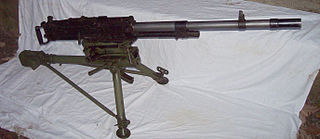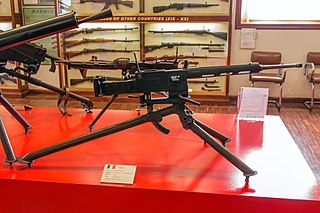
S.P.A., was an Italian automobile, military vehicle and aero-engine manufacturer founded in Turin by Matteo Ceirano and Michele Ansaldi. It was active between 1906 and 1926. In 1908, it merged with Fabbrica Ligure Automobili Genova (FLAG) and the new company, Società Ligure Piemontese Automobili, was headquartered in Genoa while manufacturing in Turin.

The Fiat L6/40 was a light tank used by the Italian army from 1940 through World War II. It was designed by Fiat-Ansaldo as an export product, and was adopted by the Italian Army when officials learned of the design and expressed interest. It was the main tank employed by the Italian forces fighting on the Eastern Front alongside the L6/40-based Semovente 47/32 self-propelled gun. L6/40s were also used in the North African campaign.

The 7.92×57mm Mauser is a rimless bottlenecked rifle cartridge. The 7.92×57mm Mauser cartridge was adopted by the German Empire in 1903–1905, and was the German service cartridge in both World Wars. In its day, the 7.92×57mm Mauser cartridge was one of the world’s most popular military cartridges. In the 21st century it is still a popular sport and hunting cartridge that is factory-produced in Europe and the United States.

The Fiat G.55 Centauro was a single-engine single-seat World War II fighter aircraft used by the Regia Aeronautica and the A.N.R. in 1943–1945. It was designed and built in Turin by Fiat. The Fiat G.55 was arguably the best type produced in Italy during World War II, but it did not enter production until 1943, when, after comparative tests against the Messerschmitt Bf 109G and the Focke-Wulf 190, the Luftwaffe itself regarded the Fiat G.55 as "the best Axis fighter".

The P 26/40 was an Italian World War II heavy tank. It was armed with a 75 mm gun and an 8 mm Breda machine gun, plus another optional machine gun in an anti-aircraft mount. The official Italian designation was Carro Armato P 26/40.

The Breda Ba.88 Lince was a ground-attack aircraft used by the Italian Regia Aeronautica during World War II. Its streamlined design and retractable undercarriage were advanced for the time, and after its debut in 1937 the aircraft established several world speed records. However, when military equipment was installed on production examples, problems of instability developed and the aeroplane's general performance deteriorated. Eventually its operational career was cut short, and the remaining Ba.88 airframes were used as fixed installations on airfields to mislead enemy reconnaissance. It represented, perhaps, the most remarkable failure of any operational aircraft to see service in World War II.

The BA-27 was a Soviet first series-produced armoured car, manufactured from 1928 to 1931, and used for scouting and infantry support duties early in the Second World War. The BA-27 was a heavy armoured car, having the same turret and armament as the first Soviet tank, T-18, manufactured at the same time: the main gun was a modified copy of the French 37 mm Puteaux SA 18 cannon, and it was supported by an additional machine gun.

The Fiat 3000 was the first tank to be produced in series in Italy. It became the standard tank of the emerging Italian armored units after World War I. The 3000 was based on the French Renault FT.
Breda-SAFAT was an Italian weapons manufacturer of the 1930s and 1940s that designed and produced a range of machine-guns and cannon primarily for use in aircraft. Based on the M1919 Browning machine gun, the Italian guns were chambered to fire indigenous ammunition with 7.7 mm (0.303 in) and 12.7 mm (0.500 in) calibres, predominantly ball, tracer for the 7.7mm, including high-explosive-incendiary-tracer (HEIT), or armour-piercing (AP) for the 12.7mm.

The AUT.18 was a prototype fighter aircraft developed in Italy by Aeronautica Umbra shortly before the outbreak of World War II. It was designed in 1934 by Ing Felice Trojani, who at that time was collaborating with Umberto Nobile on the Arctic flights of the airships Norge and Italia. The aircraft's designation came from initials of the manufacturer, the surname of the designer, and the aircraft's wing area, the sole prototype receiving the serial no. M.M.363.

The 13.2 mm Hotchkiss machine gun was a heavy machine gun designed and manufactured by Hotchkiss et Cie from the late 1920s until World War II and saw service with various nations' forces, including Italy and Japan where the gun was built under license.

The Mitragliatrice Breda calibro 8 modello 37 was an Italian heavy machine gun produced by Breda and adopted in 1937 by the Royal Italian Army. It was the standard machine gun for the Royal Italian Army during World War II, and continued to be used by the Italian Army after the conflict. The Breda 37 was meant as company/battalion support as compared to the more troublesome Breda 30 meant for squad/platoon support, and proved far more effective in combat, though possessing some of the same problematic features of the Breda 30.

The Fiat–Revelli 35 was an Italian machine gun, a modified version of the Fiat–Revelli Modello 1914, which had equipped the Italian Army of World War I.
Franz Gebauer (1888–1958) was an Austrian inventor and weapons designer, including an early power-operated machine gun which actually saw service use.

The German machine pistol EMP also known as MPE was produced by the Erma factory, and was based on designs acquired from Heinrich Vollmer. The gun was produced from 1931 to 1938 in roughly 10,000 exemplars and exported to Spain, Mexico, China and Yugoslavia, but also used domestically by the SS. It was produced under license in Spain by the arsenal of A Coruña under the designation M41/44.
8×59mmRb Breda was an Italian heavy arms cartridge. It has a rebated rim.

This article deals with the history and development of tanks employed by military forces in Italy from their first use in World War I, the interwar period, during World War II, the Cold War and modern era. The current C1 Ariete is the current main battle tank of the Italian Army.
The Breda Model 31 was a widely used Italian heavy machine gun produced by Società Italiana Ernesto Breda and used by the Italian Navy and Italian Army during World War II. At sea it was employed as a light anti-aircraft gun, while on land it was mounted on armored command vehicles where it was used as a heavy machine gun. After World War II it remained in use aboard the patrol boats of the Guardia di Finanza.















